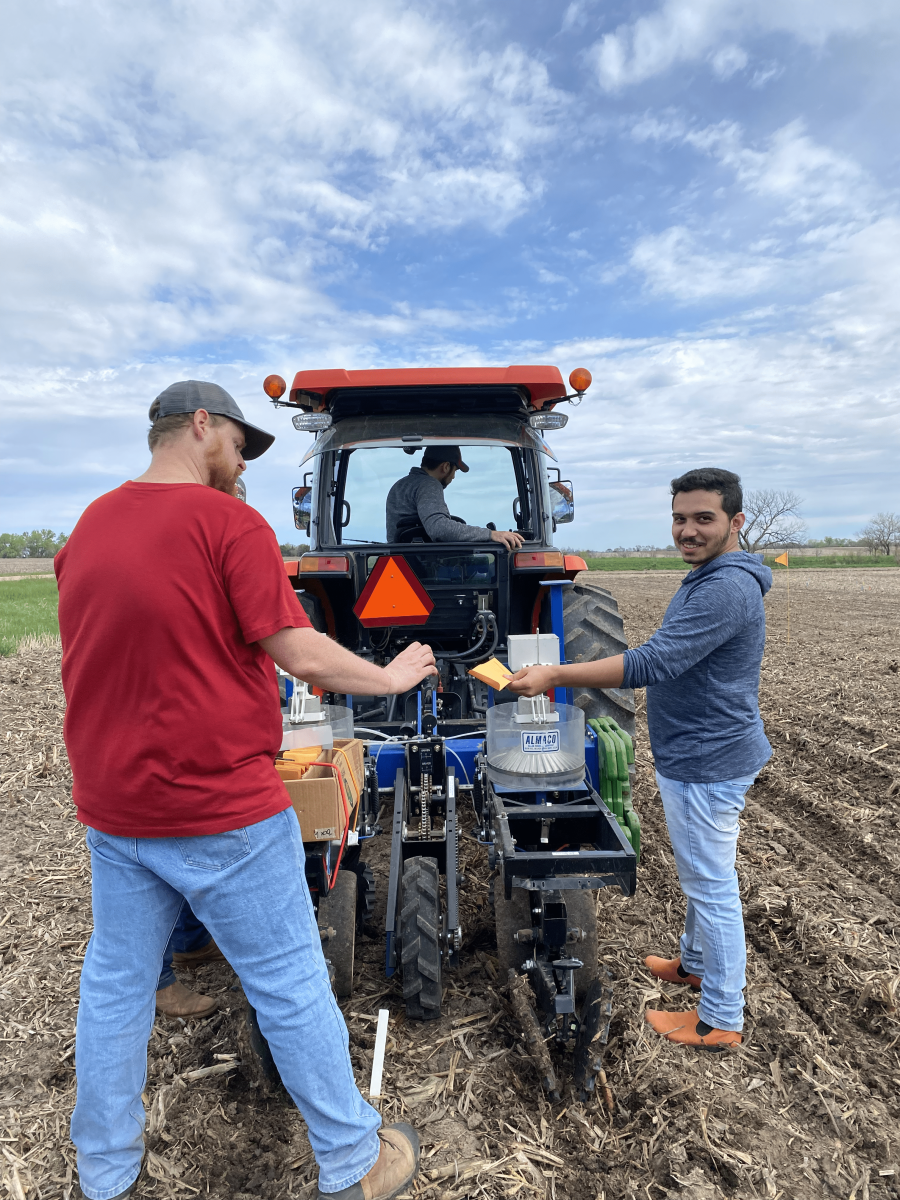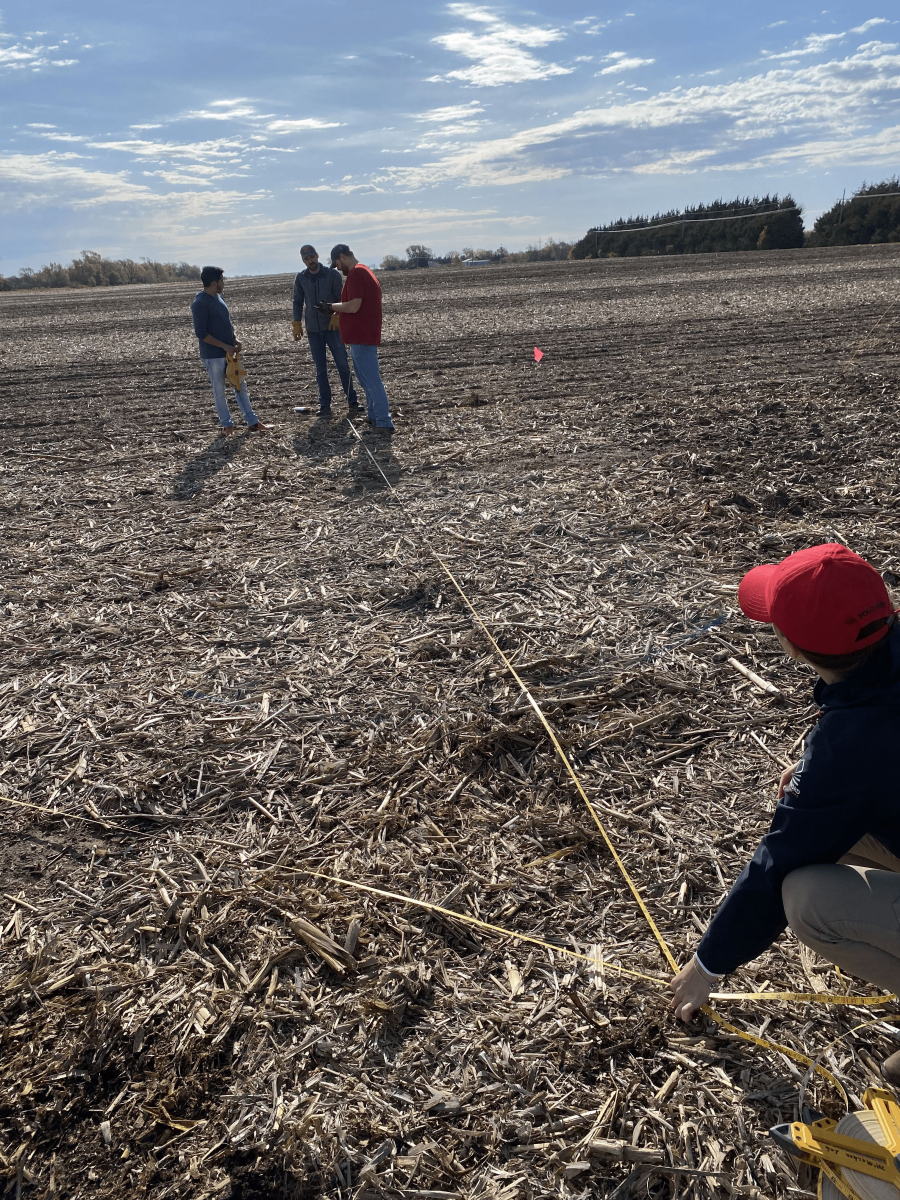Three Brazilian student are getting the chance of a lifetime to study with a faculty member and his lab in the Entomology Department at the University of Nebraska-Lincoln. Julia Pinzon, Ricardo Fuchs and Gabriel dos Santos, interns from Brazil, are working with Entomology Associate Professor Justin McMechan on his projects. This experience will expand their skills to support their own career goals.
Julia studies Agronomy at the Federal University of Rio Grande do Sul (UFRGS) while Ricardo and Gabriel study Agronomy and Biology, respectively, at the University of São Paulo (USP). They recently shared their experiences during an interview with Yasmim Spindola, communications & social media student worker with the UNL Department of Entomology.
What is the research that you are taking part in about?
Julia:
I'm doing an internship at the Department of Entomology, in Justin McMechan's lab, as part of an exchange program. Within the lab, over 20 projects are currently underway this summer, and we, as interns, are involved in all of them, assisting in their development and implementation. Additionally, we have the opportunity to conduct our own project, which is very rewarding. My project is related to a new pest that emerged in the United States in 2018 and is becoming increasingly important in the country's soybean fields. We are seeking methods of control and prevention to reduce the damage it causes. My project involves testing different depths of soybean planting: 0.5 inches, 1.5 inches, and 2.5 inches, with the aim of determining a seeding depth that might conceal the fissure at the base of the stem, through which the soybean gall midge infests the plant, thereby preventing infestation and protecting yield.
Ricardo:
The goal of my project is to look at silicate as a pre-plant application to reduce soybean gall midge infestation and injury. The literature shows that it can be effective against some insects so we wanted to test it against Soybean Gall Midge.
Gabriel:
It’s apparent that Soybean Gall Midge is difficult to control and there have been a lot of studies on different control tactics. A lot of research has gone into applications in the current years soybean to prevent or reduce infestation. The goal of my project is to apply insecticide to soil to see if it has an impact on Soybean Gall Midge as it emerges as an adult.

What are your main duties in the research?
Julia:
In the soybean planting depth project, I am responsible for the entire process, from ideation to final analysis. Throughout this process, we conduct activities such as defining the objectives, developing a experimental design and plot map, planting, monitoring the plant and pest, collecting samples, data analysis, and drawing conclusions.
Ricardo:
We have a mix of field, greenhouse, and lab work to do. At the field, we need to set the stakes, apply the treatments, and plant the trial. After everything is in, we need to track adults with cages, and monitor for infestation and injury from Soybean Gall Midge. In the lab, there is a lot of preparation work with counting seeds, making stakes, cleaning jars, etc. We also have maintain several plants in the greenhouse for projects. Also, we have our own projects to think about and conduct.
Gabriel:
In our project, we are responsible for planning, executing, and monitoring until we get the results, with the help of other members in the laboratory. In addition to that, we help with other active projects in the lab.

How did you connect with UNL and Dr. McMechan?
Julia:
Other students from my university had already come to UNL and enjoyed the experience they had, so I decided to pursue an internship at the university as well. I got in touch with one of the doctoral students in the lab, Natasha Umezu, who was the main connection between Justin and me. From the first contact with Natasha, I felt very welcomed and happy, and as soon as I had my first interview with Justin, I confirmed that his warmth extended throughout the entire lab. This was one of the strongest factors in my decision to come to the United States. Being far from home is not easy, and it is extremely important to be surrounded by welcoming people, and this reception, without a doubt, is making this experience even more incredible.
Ricardo:
I knew a Ph.D. student here, Natasha Umezu, because she studied at the same university as me in Brazil and she works in Dr. McMechan’s laboratory. Then, she sent a message to me saying that if I wanted, I could have the opportunity to work here and learn more about United States agriculture and culture.
Gabriel:
I also met Justin through Natasha Umezu since we went to the same university in Brazil. She announced the opportunity to the girls who currently live in the house she used to live in, and my girlfriend, who lives there, shared this opportunity with me.
What are the main differences between Brazil and the U.S. so far?
Julia:
There are many differences between Brazil and the United States, but from my perspective as an intern here at UNL, I believe it's the availability of resources for research, the university's infrastructure, and other aspects that are essential for the development of education and research. I was truly impressed by all of this!
Ricardo:
The university structure is much better than Brazil. Also, the investments in research here is much bigger. Finally, I like how safe Lincoln is, being one of the safest cities in the U.S.
Gabriel:
The most noticeable is the weather and the food, but the quality of life in general is also very notable, an example is the university facilities, with top-notch buildings and laboratories.
Was it easy to adapt to a new country and a new culture?
Julia:
For me, the main challenge lies in the cuisine. In the first few weeks, it was difficult, but now I'm more adapted.
Ricardo:
The citizens of Lincoln are so welcoming and it's easier to adapt. Also people from the Entomology Department are great and make us feel at home. But of course, the hardest part it's to adapt with the language, and it's taking some time.
Gabriel:
For now I have found it easy, and after a month and a half in a new country, I already feel adapted.
What do you like the most about the Department?
Julia:
What I like most about the Department of Entomology is an extremely difficult question because everything is very organized and at the same time very enjoyable, but I think for me, the warmth, affection, and patience of the people with us is what I really like the most. Within the department, we feel like we're at home, and that's very comforting for me.
Ricardo:
Everyone is so kind and welcoming that makes us feel at home. Another thing are the department seminars we have some Fridays that helps a lot to learn new things.
Gabriel:
The members of the department are very active and participate in the events, both social and academic, which makes the department very united.
.png)